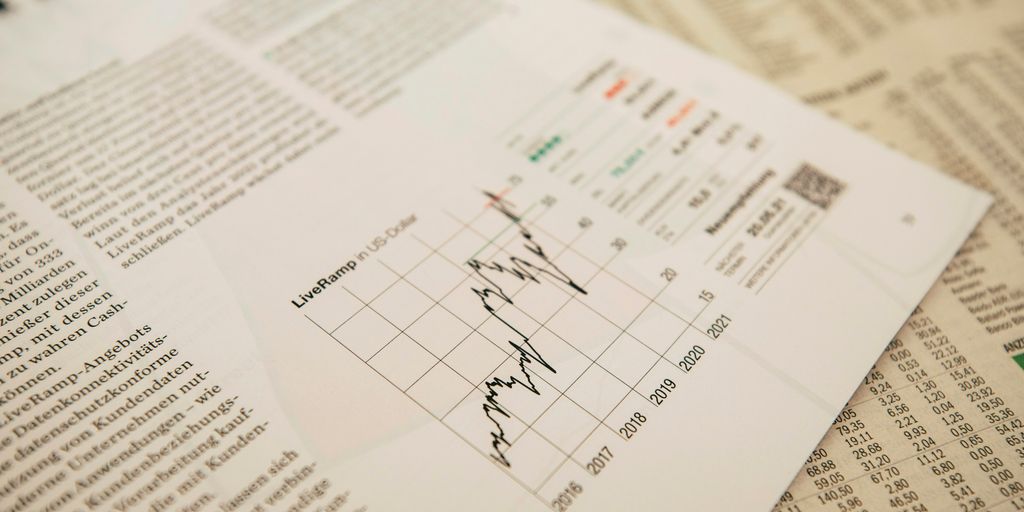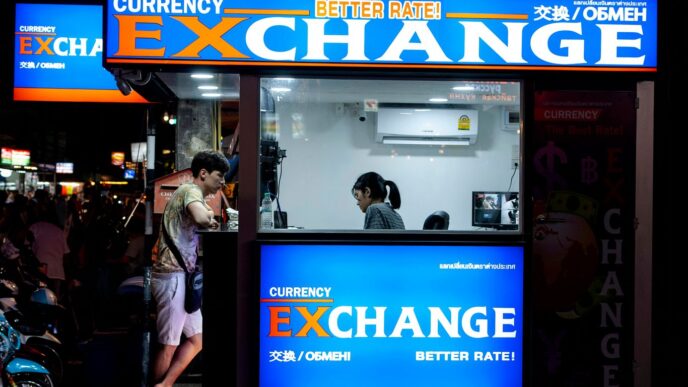Ever wonder how the government borrows money for short periods? That’s where Treasury Bills come in. Specifically, the 12 month treasury bill rate is a pretty big deal. It tells us a lot about the economy and how much it costs the U.S. government to borrow money for a year. This guide will help you get a handle on what these bills are, how they work, and why their rate matters to everyone, from big investors to regular folks just trying to understand the financial world.
Key Takeaways
- The 12 month treasury bill rate is a key indicator of short-term government borrowing costs and economic health.
- Treasury Bills are sold at a discount, and the difference between the purchase price and the face value at maturity is the investor’s return.
- You can buy 12 month T-Bills directly from the Treasury or through brokers, using non-competitive or competitive bids.
- Factors like Federal Reserve decisions, inflation, and investor sentiment all play a part in shaping the 12 month treasury bill rate.
- 12 month T-Bills are seen as very safe investments because the U.S. government backs them completely.
Understanding the 12 Month Treasury Bill Rate
Defining Treasury Bills and Their Role
Treasury bills, or T-bills, are short-term debt obligations backed by the U.S. government. They’re essentially a way for the government to borrow money for a short period. Think of it like this: you’re lending money to the government, and they promise to pay you back in a year or less. T-bills are sold at a discount, meaning you pay less than the face value, and when the bill matures, you receive the full face value. The difference is your profit. They play a big role in the money market and are considered very safe investments.
The Significance of the 12 Month Treasury Bill Rate
The 12-month T-bill rate is a key indicator of short-term interest rates and overall economic sentiment. It’s often used as a benchmark for other short-term investments. A higher rate might suggest expectations of rising interest rates or inflation, while a lower rate could indicate a slowing economy or a flight to safety. The T-bill rates can influence everything from mortgage rates to corporate borrowing costs. Plus, it gives investors a low-risk option for parking cash for a year.
How the 12 Month Treasury Bill Rate Reflects Economic Health
The 12-month T-bill rate acts like a barometer for the economy. When the economy is doing well, and investors are feeling confident, they might seek higher-yielding investments, pushing T-bill rates down. Conversely, during times of uncertainty, investors often flock to the safety of T-bills, driving prices up and yields down. Several factors influence the rate:
- Federal Reserve Policy: The Fed’s decisions on interest rates directly impact T-bill yields.
- Inflation Expectations: Higher inflation erodes the real return on T-bills, potentially pushing rates up.
- Investor Sentiment: Risk aversion increases demand for T-bills, lowering yields.
In short, the 12-month T-bill rate provides a snapshot of the market’s view on the current and future state of the economy.
The Mechanics of 12 Month Treasury Bill Pricing
Calculating the Discount Yield for 12 Month T-Bills
Treasury bills, or T-bills, don’t pay interest like a typical bond. Instead, you buy them at a discount, and when they mature, you receive the full face value. The difference between what you pay and what you get back is essentially your interest. This difference is called the discount yield. To calculate it, you need to know the par value (the amount you’ll receive at maturity), the purchase price, and the time until maturity. The US Treasury website provides reference rates.
Par Value and Discounted Purchase Price
The par value is the amount the Treasury promises to pay you when the T-bill matures. Let’s say it’s $1,000. The discounted purchase price is what you actually pay for the T-bill. This price is always less than the par value. The bigger the discount, the higher the yield. For example, you might pay $950 for a T-bill with a $1,000 par value. The US Government, through the Department of Treasury, promises to pay the investor the full par value of $1,000 of the T-bill at its specified maturity date.
Real-World Examples of 12 Month T-Bill Pricing
Let’s walk through a couple of examples to make this clear:
- Scenario 1: You buy a 12-month T-bill with a par value of $1,000 for $960. At maturity, you receive $1,000. Your profit is $40. The discount yield calculation would be (($1000 – $960) / $1000) * 100 = 4%.
- Scenario 2: Imagine you’re a big institutional investor and purchase a T-Bill with a par value of $1,000,000 for $950,000. When the T-bill matures, the Treasury promises to pay the investor the full par value of $1,000,000. In this example, the investor earns $50,000 for investing $950,000 for a year, pocketing a total of $1,000,000 upon maturity of the T-Bill in one year’s time.
These examples show how the discount yield works in practice. Remember that T-bill prices and yields change all the time based on market conditions. The maturity period affects its price. For example, a one-year T-Bill typically comes with a higher rate of return than a three-month T-Bill. The explanation for this is that longer maturities mean additional risk for investors in a normal rate environment.
Acquiring 12 Month Treasury Bills

Purchasing Through Non-Competitive Bids
So, you’re thinking about buying some 12-month Treasury Bills? Great choice! One of the easiest ways to do it is through a non-competitive bid. This means you agree to accept whatever discount rate is determined at the auction. It’s super straightforward. Think of it as saying, "I’ll take what you’re offering." This method is popular, especially if you’re an individual investor, because you’re guaranteed to get the full amount of the bill when it matures. You can make payments through TreasuryDirect or your bank/broker. It’s a pretty hands-off approach.
Engaging in Competitive Bidding Auctions
If you’re feeling a bit more strategic, you might want to try a competitive bidding auction. Here, you actually specify the discount rate you’re willing to accept. It’s a bit more involved, but it gives you a chance to potentially snag a better deal. Keep in mind, though, that there’s no guarantee your bid will be accepted. If the Treasury gets enough bids at rates lower than yours, you might miss out. It’s all about finding that sweet spot. You’ll need to do your homework and understand the market to make a smart bid. It’s not as simple as the non-competitive route, but it can be rewarding. Here are some things to consider:
- What are current market rates?
- What’s your risk tolerance?
- How much are you willing to invest?
Accessing the Secondary Market for 12 Month T-Bills
Don’t want to wait for an auction? No problem! You can also buy 12-month T-Bills on the secondary market. This is where T-Bills that have already been issued are bought and sold between investors. It’s like buying a used car, but for government debt. The price will fluctuate based on market conditions, so you’ll need to keep an eye on things. You can access the secondary market through a broker or dealer. Just remember that prices can change quickly, so be prepared to act fast. It’s a good option if you need to buy or sell T-Bills outside of the regular auction schedule. Plus, it adds some flexibility to your investment strategy.
Key Influencers on the 12 Month Treasury Bill Rate
It’s interesting to think about what actually moves the needle on those 12-month T-bill rates. It’s not just one thing, but a bunch of factors all working together. Let’s break down some of the big ones.
Impact of Federal Reserve Monetary Policy
The Fed plays a huge role, no surprise there. The Federal Reserve’s actions on monetary policy significantly impact T-bill rates. When the Fed changes interest rates, T-bill rates tend to follow. If the Fed raises rates, new T-bills will be issued at higher rates, making older, lower-rate T-bills less attractive. This causes their prices to drop. It’s all about keeping things competitive in the market. Think of it like this: if your neighbor starts selling lemonade for 50 cents a glass, you might have to lower your price to match, even if you were charging more before.
The Role of Inflation on T-Bill Rates
Inflation is another biggie. If inflation is high, people want a higher return on their investments to make up for the fact that their money is losing value. Imagine you’re lending someone money, but you know that everything will cost 5% more next year. You’d want to charge them more interest to compensate, right? It’s the same with T-bills. If investors expect inflation to rise, they’ll demand higher yields on nominal yield to maintain their real return. This can lead to lower demand for existing T-Bills, and therefore, lower prices.
Investor Risk Tolerance and Market Dynamics
Finally, what investors are feeling also matters. Are they scared and looking for safety, or are they feeling bold and chasing higher returns? When the market is shaky, people flock to the safety of T-bills, driving up their prices and lowering their yields. T-bills are seen as a safe haven, backed by the government. But when the economy is booming, and riskier investments like stocks are offering bigger potential gains, T-bills become less appealing. This decreased demand can push T-bill prices down. It’s all about supply and demand, and municipal bond market sentiment plays a big part.
Comparing 12 Month Treasury Bills with Other Treasuries
Distinguishing T-Bills from T-Notes
Okay, so you’re looking at 12-month T-bills, but what about T-notes? They’re both government debt, but they work a bit differently. The big difference is the maturity date. T-bills, including the 12-month variety, mature in a year or less. Treasury notes, on the other hand, have maturities ranging from two to ten years. Another key difference is how they pay out. T-bills are sold at a discount, and you get the face value at maturity. T-notes pay a fixed interest rate every six months until they mature. You can think of Treasury Notes as a longer-term investment compared to T-bills.
Understanding the Differences with T-Bonds
Now, let’s throw T-bonds into the mix. T-bonds are the long-term players in the Treasury market. They have maturity periods between 20 and 30 years. Like T-notes, T-bonds also pay interest every six months. So, if you’re looking for a really long-term, fixed-income investment, T-bonds are something to consider. But remember, with longer terms comes more exposure to interest rate risk. Here’s a quick comparison:
| Feature | T-Bill | T-Note | T-Bond |
|---|---|---|---|
| Maturity | 1 year or less | 2-10 years | 20-30 years |
| Interest Payment | Discount | Semi-annual | Semi-annual |
| Risk | Generally lower | Moderate | Higher |
Maturity Periods and Investment Implications
So, why does the maturity period matter? Well, it all boils down to your investment goals and risk tolerance. If you need cash in the short term, like within a year, a 12-month T-bill is a solid choice. It’s safe, and you know exactly when you’ll get your money back. If you’re looking for something longer-term and want regular income, T-notes or T-bonds might be a better fit. Just keep in mind that longer-term bonds are more sensitive to changes in interest rates. If rates go up, the value of your bond investments could go down. Here are some things to consider:
- Investment Horizon: How long do you want to invest?
- Risk Tolerance: How much risk are you comfortable with?
- Income Needs: Do you need regular income payments?
- Interest Rate Outlook: What do you think will happen to interest rates?
The Safety and Stability of 12 Month Treasury Bills

Government Backing and Investment Security
Treasury Bills, especially the 12-month variety, are often seen as one of the safest investments you can make. Why? Because they’re backed by the full faith and credit of the U.S. government. This means the government promises to pay you back, and that promise is about as solid as it gets in the investment world. It’s like lending money to a friend who always pays you back, no matter what. Because of this backing, T-Bills are considered virtually risk-free. You’re not going to get rich quick with them, but you’re also not likely to lose your shirt. This makes them a popular choice for people who are risk-averse or who are looking for a safe place to park their money for a short period. You can think of them as a financial anchor in a sometimes stormy sea.
T-Bills as a Baseline for Other Investments
Because T-Bills are so safe, they’re often used as a benchmark to measure the risk and return of other investments. Think of it like this: if a T-Bill is paying 2%, then any other investment needs to offer a significantly higher return to be worth the extra risk. Investors use the T-Bill interest rates as a kind of hurdle rate. If a corporate bond is only paying 2.5%, is that extra 0.5% worth the risk of the company going bankrupt? Maybe, maybe not. But the T-Bill gives you a starting point for that calculation. It’s a way to compare apples to oranges, or at least, to compare very safe apples to potentially bruised oranges. Here’s why they are a good baseline:
- Low Risk: They are considered virtually risk-free due to government backing.
- Liquidity: They are easily bought and sold.
- Predictable Returns: The return is known at the time of purchase.
Funding Government Operations with T-Bills
When you buy a 12-month T-Bill, you’re essentially lending money to the U.S. government. The government uses this money to fund its operations, pay for infrastructure projects, and manage the national debt. It’s a way for the government to borrow money in the short term, and it’s a crucial part of how the government finances itself. The government expenses are paid, in part, by the sale of these bills. The auctions of T-Bills are a regular event, and they help the government to refinance existing debt and to raise new funds as needed. So, by investing in T-Bills, you’re not only getting a safe return on your investment, but you’re also helping to keep the wheels of government turning. It’s a small piece of the puzzle, but it’s an important one.
Strategic Investment in 12 Month Treasury Bills
Short-Term Investment Opportunities
12 Month Treasury Bills can be a solid choice if you’re looking for somewhere to park your cash for a year. They offer a predictable return with very low risk, making them ideal for short-term goals. Think of it like this: you know exactly when you’ll get your money back, and you know it’s backed by the U.S. government. This makes them useful for things like saving for a down payment, a vacation, or just building up an emergency fund. Plus, they’re pretty liquid, meaning you can usually sell them before maturity if you need the money sooner, though that might affect your return.
Diversifying Portfolios with T-Bills
Adding 12 Month T-Bills to your investment mix can help balance things out. Here’s why:
- Low Correlation: T-Bills don’t usually move in the same direction as stocks or other riskier assets. This means that when the stock market dips, your T-Bills can help cushion the blow.
- Reduced Volatility: Because they’re so safe, T-Bills add stability to your portfolio. This can be especially helpful if you’re nearing retirement or just want to sleep better at night.
- Income Generation: While the returns aren’t huge, T-Bills do provide a steady stream of income. This can be useful for retirees or anyone looking for a bit of extra cash flow. You can compare them to other short duration products to see if they fit your investment strategy.
Considerations for Individual and Institutional Investors
Whether you’re an individual investor or managing money for a big institution, there are a few things to keep in mind when considering 12 Month T-Bills:
- Investment Goals: What are you trying to achieve? If you’re looking for high growth, T-Bills probably aren’t the best choice. But if you prioritize safety and stability, they can be a good fit.
- Tax Implications: The interest earned on T-Bills is subject to federal income tax, but it’s exempt from state and local taxes. This can be a significant advantage, especially if you live in a high-tax state.
- Opportunity Cost: While T-Bills are safe, they also offer relatively low returns. Before investing, consider whether you could earn more by taking on a bit more risk. For example, you might consider treasury notes if you are looking for a slightly longer term investment.
Here’s a quick comparison table:
| Factor | Individual Investors | Institutional Investors |
|---|---|---|
| Investment Goals | Safety, short-term savings, tax advantages | Liquidity management, regulatory compliance, hedging |
| Investment Size | Smaller, often under $100,000 | Larger, often millions of dollars |
| Risk Tolerance | Generally lower | Varies depending on the institution’s mandate |
| Due Diligence | Less extensive, often based on readily available information | More rigorous, involving detailed financial analysis |
Conclusion
So, there you have it. The 12-month Treasury Bill rate might seem like a small detail, but it’s actually a pretty big deal in the financial world. It tells us a lot about what’s going on with the economy, how the government is managing its money, and even gives us a hint about where interest rates might be headed. Keeping an eye on this rate can help you make smarter choices with your own money, whether you’re just saving up or thinking about bigger investments. It’s all about understanding the basics, and hopefully, this helped clear some things up for you.
Frequently Asked Questions
What exactly is a 12-month Treasury Bill?
A 12-month Treasury Bill is a short-term loan you give to the U.S. government for one year. Instead of paying you interest regularly, the government sells it to you at a lower price than what it will be worth when it matures. The difference between what you pay and what you get back is your profit.
How can I purchase 12-month Treasury Bills?
You can buy 12-month T-Bills directly from the U.S. Treasury through their TreasuryDirect website. You can also buy them through banks, brokers, or on the secondary market, which is where people trade T-Bills that have already been issued.
What factors affect the interest rate on a 12-month Treasury Bill?
The rate on a 12-month T-Bill is influenced by several things. The Federal Reserve’s interest rate decisions, how much inflation there is, and how much risk investors are willing to take all play a part. If the economy is shaky, more people might want T-Bills, driving their price up and their yield down, because they are seen as very safe.
Are 12-month Treasury Bills a safe investment?
T-Bills are generally considered one of the safest investments because they are backed by the full faith and credit of the U.S. government. This means the government promises to pay you back, making them very low-risk.
What’s the difference between a 12-month Treasury Bill and a Treasury Note or Bond?
While both are ways to lend money to the government, T-Bills are short-term, maturing in a year or less, and don’t pay regular interest. T-Notes, on the other hand, are medium-term (2-10 years) and pay interest every six months. T-Bonds are long-term (20-30 years) and also pay interest every six months.
Why would someone choose to invest in a 12-month Treasury Bill?
Many investors use 12-month T-Bills for short-term savings or to keep their money safe when other investments feel too risky. They can also be a good way to balance out a portfolio that includes more volatile assets, providing a stable base.














